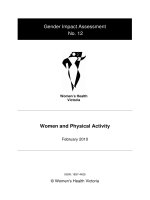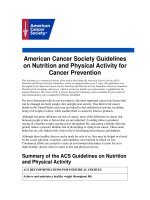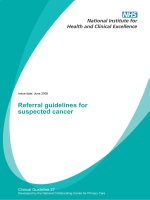Nutrition and Physical Activity Guidelines for Gynecological Cancer Survivors ppt
Bạn đang xem bản rút gọn của tài liệu. Xem và tải ngay bản đầy đủ của tài liệu tại đây (615.39 KB, 6 trang )
Department of Nutrition Therapy (813)-745-6866
This handout contains simple advice that
This handout contains simple advice that This handout contains simple advice that
This handout contains simple advice that
has been specifically
has been specifically has been specifically
has been specifically
designed for ovarian, cervical, and
designed for ovarian, cervical, anddesigned for ovarian, cervical, and
designed for ovarian, cervical, and
endometrial cancer survivors.
endometrial cancer survivors. endometrial cancer survivors.
endometrial cancer survivors.
Nutrition and Physical Activity
Nutrition and Physical Activity Nutrition and Physical Activity
Nutrition and Physical Activity
Guidelines for
Guidelines for Guidelines for
Guidelines for
Gynecological Cancer Survivors
Gynecological Cancer Survivors Gynecological Cancer Survivors
Gynecological Cancer Survivors
Gynecological Cancer risk is influenced by several
Gynecological Cancer risk is influenced by several Gynecological Cancer risk is influenced by several
Gynecological Cancer risk is influenced by several
factors. Some of these factors are controllable.
factors. Some of these factors are controllable.factors. Some of these factors are controllable.
factors. Some of these factors are controllable.
Controllable lifestyle factors that are known
Controllable lifestyle factors that are known Controllable lifestyle factors that are known
Controllable lifestyle factors that are known
to influence cancer risk include eating habits and
to influence cancer risk include eating habits and to influence cancer risk include eating habits and
to influence cancer risk include eating habits and
physical activity.
physical activity. physical activity.
physical activity.
The following guidelines can help you to boost
The following guidelines can help you to boost The following guidelines can help you to boost
The following guidelines can help you to boost
your body’s ability to resist cancer.
your body’s ability to resist cancer.your body’s ability to resist cancer.
your body’s ability to resist cancer.
Department of Nutrition Therapy (813)-745-6866
Control Body Weight
•
Overweight and obesity increase the risk of cer-
tain cancers amongst other common chronic dis-
eases.
•
Risk of endometrial cancer increases with in-
creased body fatness and abdominal fatness. So,
aim to be as lean as possible within the normal
weight for your height.
•
If overweight, any reduction in body fatness can
reduce risk!
•
Watching portion sizes, eating a plant-based diet
high in non-starchy vegetables, cutting down on
high-fat foods, and increasing physical activity
can help lower weight and reduce body fatness.
Body Mass Index
(BMI)
•
BMI is calculated
from a person’s
height and weight
and can be a reli-
able indicator of
body fatness.
•
A BMI between
18.5 and 24.9 is
equated with a
“healthy” weight
•
Use the chart on
the right to deter-
mine where you
are.
Department of Nutrition Therapy (813)-745-6866
Move Towards a Plant-based Diet
Goal: Make unprocessed cereals (grains), non
Goal: Make unprocessed cereals (grains), nonGoal: Make unprocessed cereals (grains), non
Goal: Make unprocessed cereals (grains), non-
-starchy vegetables, fruits, and
starchy vegetables, fruits, and starchy vegetables, fruits, and
starchy vegetables, fruits, and
legumes (beans) the focus of every meal!
legumes (beans) the focus of every meal!legumes (beans) the focus of every meal!
legumes (beans) the focus of every meal!
•
These foods are typically high in nutrients, high in dietary fiber, and low in energy
density.
•
They provide a feeling of fullness without the added calories and can help prevent
weight gain.
•
To find unprocessed grains, look for “whole grain” on nutrition food package labels as
one of the first three ingredients for packaged foods.
•
Beans are a great low-fat, high protein alternative to meat.
•
Starchy vegetables like potato, yam, and cassava are also included in a plant-based diet
as are nuts and seeds.
•
Nuts and seeds provide protein and heart-health fats, but do have a higher energy
density, so watch your portion size.
Eat More Fruits & Vegetables
Goal: Eat 5
Goal: Eat 5 Goal: Eat 5
Goal: Eat 5 or more
or more or more
or more servings a day!
servings a day!servings a day!
servings a day!
•
Eat a variety all year round. More variety means more protective elements
(antioxidants)!
•
Evidence suggests that non-starchy vegetables such as broccoli, spinach,
mushrooms, peppers, tomatoes, zucchini, leafy greens, and beets decrease
cancer risk particularly of ovarian and endometrial cancers. The more you
eat, the greater the risk reduction!
•
Carotenoids are antioxidants found in carrots and in dark green leafy vege-
tables. Eating carrots has been shown to play a role in decreasing risk of
cervical cancer.
•
To reap the most rewards of eating fruits and vegetables, eat them in their
whole form versus as juice or supplements.
Department of Nutrition Therapy (813)-745-6866
Additional Nutrition Advice to Help
Control Weight and Reduce Cancer Risk
Limit Intake of Red Meat
Goal: Eat no more than 18
Goal: Eat no more than 18 Goal: Eat no more than 18
Goal: Eat no more than 18
ounces of red meat a week
ounces of red meat a weekounces of red meat a week
ounces of red meat a week!
•
Evidence suggests that increased intake of red
meat increases risk of endometrial cancer.
•
Red meat includes beef, pork, and lamb.
•
Choose lean cuts of red meat with little or no
visible fat. Lean meats provide protein, iron,
zinc, and vitamin B12 with less saturated fat and
calories.
•
Avoid red meats that have been processed by
smoking, curing, salting, or the addition of
chemical preservatives.
•
Replace red meat with seafood, fish, and skinless,
white meat chicken or turkey.
Lean Beef
Lean BeefLean Beef
Lean Beef
Arm roast
Chuck roast
Extra lean ground beef
Flank steak
Ground chuck
Ground round
Round steak (rump roast)
Sirloin
Tenderloin
Lean Pork
Lean PorkLean Pork
Lean Pork
Tenderloin
Loin chops
Loin roast
Increase Fiber Intake
Goal: Aim for 20
Goal: Aim for 20Goal: Aim for 20
Goal: Aim for 20-
-30 grams a day
30 grams a day30 grams a day
30 grams a day!
•
Food high in fiber are typically low in fat
and calories while helping you feel full
and satisfied.
•
High fiber intake can reduce blood levels
of estrogen which may decrease risk of
developing or promoting ovarian and en-
dometrial cancer cells.
•
Some surgeries or procedures used to
treat GYN cancers may required following
a low fiber diet. Check with your MD or
dietitian if unsure.
High Fiber Foods
High Fiber FoodsHigh Fiber Foods
High Fiber Foods
Include these foods at each meal to boost fiber
Include these foods at each meal to boost fiber Include these foods at each meal to boost fiber
Include these foods at each meal to boost fiber
•
Bran cereal
•
Fiber One cereal
•
Whole wheat bread
•
Brown rice
•
Beans: kidney, lentil,
pinto, lima, etc.
•
Spinach
•
Broccoli
•
Corn
•
Raspber-
ries
•
Figs
•
Prunes
•
Pears
Department of Nutrition Therapy (813)-745-6866
What are you drinking?
Goal: Limit alcohol intake to one drink a day or less. Abstain entirely if able!
Goal: Limit alcohol intake to one drink a day or less. Abstain entirely if able!Goal: Limit alcohol intake to one drink a day or less. Abstain entirely if able!
Goal: Limit alcohol intake to one drink a day or less. Abstain entirely if able!
•
Evidence shows that even minimal amounts of alcohol intake increases cancer risk.
•
Since alcohol increases blood estrogen levels, it can promote ovarian and endometrial
cancer cell growth
•
All alcoholic drinks have the same effect in regard to cancer risk.
•
If you decide to drink alcohol, limit consumption to one drink a day: 12 ounces of beer, 5
ounces of wine, or 1 1/2 ounces of liquor.
Goal: Avoid sugary drinks!
Goal: Avoid sugary drinks!Goal: Avoid sugary drinks!
Goal: Avoid sugary drinks!
•
Sugary drinks are drinks with added sugar like soda and fruit punch.
•
In general, sugary drinks supply added calories with little other nutrition
value.
•
Since sugary drinks do not induce a feeling of fullness, people tend to over
consume them which leads to weight gain.
Get your nutrition from diet alone!
Get your nutrition from diet alone!Get your nutrition from diet alone!
Get your nutrition from diet alone!
•
Dietary supplements are not recommended
for cancer prevention.
•
High or “mega” doses of supplements
could increase cancer risk.
•
Supplements do not provide energy since
they do not have any calories.
•
Discuss supplement use with your physician
or a Registered Dietitian.
•
If you do decide to take supplements, look
for the USP, NSF, or Consumer Lab
symbol on the bottle which indi-
cates the manufacturers have partici-
pated in voluntary testing of their
product to ensure quality and purity
of the product.
•
Studies on soy have produced conflicting
results in regard to cancer risk.
•
Do not start eating soy foods solely for
the purpose of cancer prevention.
•
If you are already eating soy foods as a
part of your regular diet, up to three
servings of whole soy foods a day is
considered safe and acceptable!
•
Do not
notnot
not use soy powders, pills, or other
soy supplements.
Soy Story Supplement Savvy
Department of Nutrition Therapy (813)-745-6866
Physical Activity
Goal: 30 minutes of moderate physical activity 5 or more days a week!
Goal: 30 minutes of moderate physical activity 5 or more days a week!Goal: 30 minutes of moderate physical activity 5 or more days a week!
Goal: 30 minutes of moderate physical activity 5 or more days a week!
•
Physical activity in any form protects against certain types of cancer and against
weight gain.
•
Evidence shows that increased physical activity reduces risk of endometrial cancer.
•
Every minute counts, so start with what you can do now and work up to 30 minutes
at a time. Ten minutes done three times a day is a good place to start if you can’t
do 30 minutes continuous.
•
Get permission from your physician first!
Get permission from your physician first!Get permission from your physician first!
Get permission from your physician first!
•
Choose the right exercise for you.
∗
Do what you feel you are able to do and something you enjoy doing.
∗
Go to a group class or find an exercise buddy to feel a sense of camaraderie and
for extra motivation. Moffitt offers group classes like Yoga!
•
Set attainable and realistic goals that are important to you.
•
Get involved in a support group to talk about your thoughts and challenges.
•
Talk to health care professionals like a Personal Trainer or Physical Therapist for exer-
cise ideas.
•
Keep a journal. It’s one of the top tools for success!!!
∗
Track how you feel about the process.
∗
Track and monitor your progress.
•
Be flexible. Allow yourself a little bit of wiggle room.
•
Avoid negative self-talk. Keep positive!
•
Reward yourself with a massage or similar treat.
•
Fit exercise into your busy life. Making time for exercise is
making time for yourself.
∗
Exercise with kids/spouse/friend.
∗
Make exercise dates.
∗
Take the stairs, walk at lunch.
Recipe for Success
What is Moderate Activity?
Moderate physical activity gets you moving, gets
your heart rate up, makes breathing a little more
difficult, generates body heat, and is something you
couldn’t do all day or while singing a song!
An example would be brisk walking.









